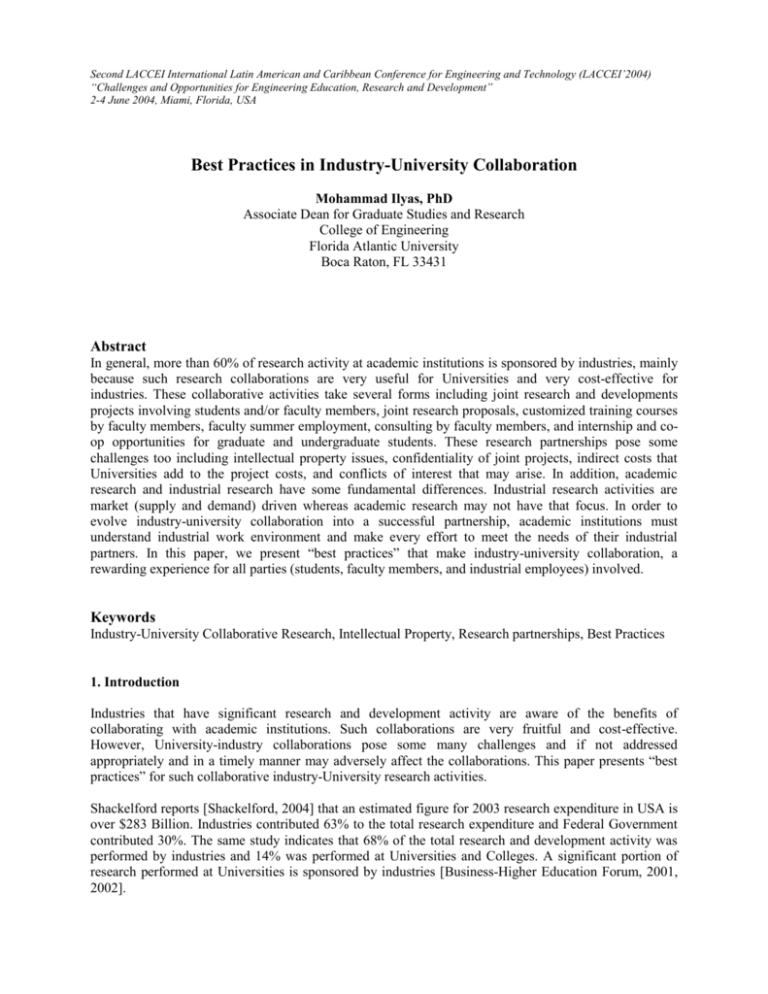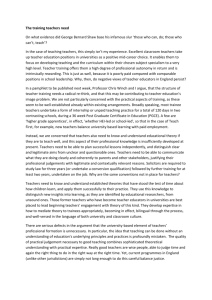INFORMATION TECHNOLOGY AND TELEMEDICINE
advertisement

Second LACCEI International Latin American and Caribbean Conference for Engineering and Technology (LACCEI’2004) “Challenges and Opportunities for Engineering Education, Research and Development” 2-4 June 2004, Miami, Florida, USA Best Practices in Industry-University Collaboration Mohammad Ilyas, PhD Associate Dean for Graduate Studies and Research College of Engineering Florida Atlantic University Boca Raton, FL 33431 Abstract In general, more than 60% of research activity at academic institutions is sponsored by industries, mainly because such research collaborations are very useful for Universities and very cost-effective for industries. These collaborative activities take several forms including joint research and developments projects involving students and/or faculty members, joint research proposals, customized training courses by faculty members, faculty summer employment, consulting by faculty members, and internship and coop opportunities for graduate and undergraduate students. These research partnerships pose some challenges too including intellectual property issues, confidentiality of joint projects, indirect costs that Universities add to the project costs, and conflicts of interest that may arise. In addition, academic research and industrial research have some fundamental differences. Industrial research activities are market (supply and demand) driven whereas academic research may not have that focus. In order to evolve industry-university collaboration into a successful partnership, academic institutions must understand industrial work environment and make every effort to meet the needs of their industrial partners. In this paper, we present “best practices” that make industry-university collaboration, a rewarding experience for all parties (students, faculty members, and industrial employees) involved. Keywords Industry-University Collaborative Research, Intellectual Property, Research partnerships, Best Practices 1. Introduction Industries that have significant research and development activity are aware of the benefits of collaborating with academic institutions. Such collaborations are very fruitful and cost-effective. However, University-industry collaborations pose some many challenges and if not addressed appropriately and in a timely manner may adversely affect the collaborations. This paper presents “best practices” for such collaborative industry-University research activities. Shackelford reports [Shackelford, 2004] that an estimated figure for 2003 research expenditure in USA is over $283 Billion. Industries contributed 63% to the total research expenditure and Federal Government contributed 30%. The same study indicates that 68% of the total research and development activity was performed by industries and 14% was performed at Universities and Colleges. A significant portion of research performed at Universities is sponsored by industries [Business-Higher Education Forum, 2001, 2002]. Collaborative research between industries and Universities is extremely beneficial to both sides. This provides a means for industries as well as for Universities to advance their research agendas in pursuing new knowledge, develop new products, and serve the society. In addition, many research advances are occurring in multifaceted disciplines and Universities are well positioned to support multidisciplinary interactions. Universities are also well positioned to attract research funding and other resources from a variety of sources. Students working on collaborative projects benefit the most. They gain academic credit for their collaborative research and also become a valuable and well trained resource for industries. A large number of these students become employees of industries that sponsored the research projects that they worked on. Several modes of industry-University collaboration are discussed in the next section. Section 3 discusses the challenges involved in such collaborative research activities. Some best practices for collaborative activities are presented in section 4. Finally a summary is presented in section 5. 2. Modes of Collaboration There are several modes collaboration between Industries and Universities, including the following: research and developments projects involving faculty and/or graduate students joint research proposals for attracting funds from federal and other sources customized education/training courses for industry employees faculty summer employment opportunities and consulting opportunities internship and co-op opportunities for graduate and undergraduate students It is well known that Industry-University collaboration represents one of the most cost-effective and rewarding methods for completing projects successfully. 2.1 Research and Development Projects Industries (or a consortium of industries) may use the expertise available at the Universities for their research and development projects. Based on the requirements of a project, faculty members and/or graduate students may be engaged in the project. To begin the process, an agreement should be signed between the industry and the University outlining the scope of the project, its duration, and the budget. The graduate students and faculty members can work on a project at the business’ site (on-site) or at the University (off-site). Graduate students can be chosen through an interview process. Graduate students are usually assigned to the project for a semester at a time. The University prepares the contracts for the individuals involved in the project, handles the payment to the individuals, and sends invoices for services rendered. In turn, the company pays the University directly. A project contact person should be assigned by both the parties and frequent communication between both sides should be a requirement for a successful collaboration. In the case of a consortium of industries, each industrial partner pays an annual membership fee and shares the research results. The consortium members collectively decide about the research direction and specific research projects 2.2 Joint Research Proposals There are numerous opportunities for attracting State and Federal funding for joint research proposals. Universities are generally eager to hands with an industrial partner to submit research proposals to appropriate funding agencies on topics of interest to both parties. 2.3 Customized Training Courses Universities, in general, have a wide spectrum of expertise and multidisciplinary skills. Customized training courses can be delivered by the faculty members on state of the art subjects. Such courses can be scheduled and delivered at a desired pace and in a desired setting preferred by the employees and management of the company. In many cases, these courses can be used by employees to earn credit for their graduate degrees. 2.4 Faculty Summer Employment: Faculty members are encouraged to seek industry experience during summer semesters. This activity provides an opportunity for faculty members to have hands-on experience, to gain knowledge about emerging technologies, and to observe trends in the field of their interest. The faculty members then bring the experiences back and integrate it into courses taught by them. Through participation in these courses, students gain the additional knowledge which makes them more valuable and marketable in the workplace. 2.5 Consulting by Faculty Members: Faculty members are generally allowed spend a certain percentage (typically about 20%) of their time on consulting activities assuming it does not interfere with their normal responsibilities. This is a valuable resource for industries to utilize the faculty talent pool as needed. Compensation for this type of arrangement is negotiated between the company and faculty member. 2.6 Internship and Co-op Opportunities: Universities also maintain an active co-op program for undergraduate students and an internship program for graduate students. Co-op students can work alternating (full-time student one semester and full-time employee the next semester) or parallel (part-time student and part-time employee each semester). The Graduate Summer Internship program can be either full-time or part-time employment. 3. Challenges There are many challenges in establishing successful and sustainable collaborative relationships between industries and Universities. Many are due to cultural workplace differences. However, if carefully evaluated and appropriately addressed, these challenges can be overcome. The challenges include the following: 3.1 Management Successful management of collaborative research projects is a key to maintaining fruitful and long-lasting relationship between industries and Universities. Frequent communication between both the sides is very crucial item in managing such projects. Such communication must address the status reports, any concerns, change of direction, milestones etc. It is always better to such discussions during the project rather than towards the end. 3.2 Confidentiality The industries keep their scientific knowledge and inventions confidential for maintaining their competitiveness. However, Universities work in a very open environment, publish their research work in widely circulated journals and present their research at technical conferences. That is how Universities create more and more knowledge. In joint industrial-University collaborations, this aspect needs to be addressed carefully. The research results coming from joint projects must be protected before its dissemination so that rights of all parties involved are appropriately addressed. 3.3 Conflicts of Interest Potential conflicts of interest in industry-University collaborative research projects should be carefully watched to avoid legal ramifications. Such conflicts may arise when a researcher has some personal financial (or other) interest with the industry that University is partnering with. Unless addressed appropriately at the outset, such conflicts may be detrimental to the collaborative efforts. 3.4 Intellectual Property One of the most difficult parts of the negotiations in industry-University collaborative agreements is the intellectual property, its value, and its ownership rights related to the joint research and development projects. A common starting position from the Universities is that the intellectual property belongs to the University and they may license it to the industry if so desired. A common settlement position leads to a joint ownership rights. When federal research funds are involved, the intellectual property usually belongs to the University. Otherwise, industries like to have ownership in order to develop, manufacture, and market products developed by collaborative research efforts. Universities, in general, have an elaborate arrangement to distribute royalty income derived from the products that emanate from faculty research. Such arrangements include faculty members (inventors), their department and/or college, and the University as potential recipients of the royalty income. 3.5 Indirect Costs (Overhead) Indirect costs (commonly referred to as overhead), are the costs that Universities add to the direct cost of a projects sponsored by industries and/or other funding agencies. These indirect costs account for the use of facilities and the time spent of the University personnel on administering such research projects. These add-on costs are also called facilities and administrative (F&A) costs. These costs are computed as a percentage (usually about 50%) of the direct costs that include salaries and wages, fringe benefits, expenses, travel. Indirect costs are not computed on equipment costs and tuition paid for the students. 4. Best Practices The following “best practices” have been known for establishing and maintaining successful relationship for prolific industry-University collaborative research efforts: Industry-University collaborative agreements must be based on mutual benefits of both sides including willingness and active participation of faculty members and students. Universities should assist interested faculty members in identifying industrial partners for collaborative research projects. Such projects should be within faculty members’ interest and strengths of the University. Participating faculty members should receive appropriate credit in their promotion and tenure considerations, for their collaboration with industries. University administration should provide an environment where industry-University collaborative work may thrive. This should include a positive encouragement for collaboration, and appropriate incentives for those involved in such activities. When an industry-university collaborative relationship is of larger magnitude, is among many departments, and involves many individuals from industry’s management, it may be better to establish a master agreement. In that case, any new collaborative project may not need a new agreement and hence will not be unnecessarily delayed and can begin as soon as scope of the project can be defined. Non-disclosure (confidentiality agreements), when necessary, should be signed by all parties and individuals involved in a collaborative projects before the research work begins. This includes the faculty members, students, and other individuals/researchers involved in the project. This should specifically address policy on research publications and/or conference presentations. Industries may not be aware of the indirect costs that Universities add on to all the direct project costs. Such costs and any exceptions to those should be clearly mentioned in the negotiated agreements. Intellectual property ownership should be negotiated with as much flexibility as possible from all collaboration partners so that this does not become as issue that stalls every project. In addition, Universities should periodically update their policies on intellectual property for the maximum benefit to all the parties involved and to enhance the service to the community at large. Industries and Universities should encourage expedited process for establishing partnerships. Many times such partnership decisions need to be made in a relatively shorter period of time and lengthy procedures at either side may obviate establishment of partnerships. Industries and Universities should set up a mechanism for frequent communication on the progress and directions of collaborative projects. Such a mechanism will keep the project moving forward and assure its timely progress. 5. Summary and Conclusions This paper has addressed industry-University collaborations in joint research and development activities. Such research collaborations are very useful for Universities and very cost-effective for industries. These collaborative activities take several forms including joint research projects, research proposals, customized training courses by faculty members, faculty summer employment, consulting by faculty members, and internship and co-op opportunities for graduate and undergraduate students. The research partnerships pose some challenges too including intellectual property issues, confidentiality of joint projects, indirect costs that Universities add to the project costs, and conflicts of interest that may arise. In order to evolve industry-university collaboration into a successful partnership, academic institutions must understand industrial work environment and make every effort to meet the needs of their industrial partners. This paper has presented “best practices” that make industry-university collaboration, a rewarding experience for all parties (students, faculty members, and industrial employees) involved. 6. References Shackelford, B., “US R&D Projected to Have Grown Marginally in 2003”, National Science Foundation, Division of Science Resource Statistics (NSF 04-307), February 2004. “Working Together, Creating Knowledge: The University-Industry Research Collaboration Initiative”, Business-Higher Education Forum, 2001. “Investing in People, Developing All of America’s Talent on Campus and in the Workplace”, BusinessHigher Education Forum, 2002. “Making IT Better: Expanding Information Technology Research to Meet Society’s Needs”, Computer Science and Telecommunications Board, National Research Council, 2000. Gilman, J., “Inventivity: The Art and Science of Research Management”, Van Nostrand Reinhold, 1992.







